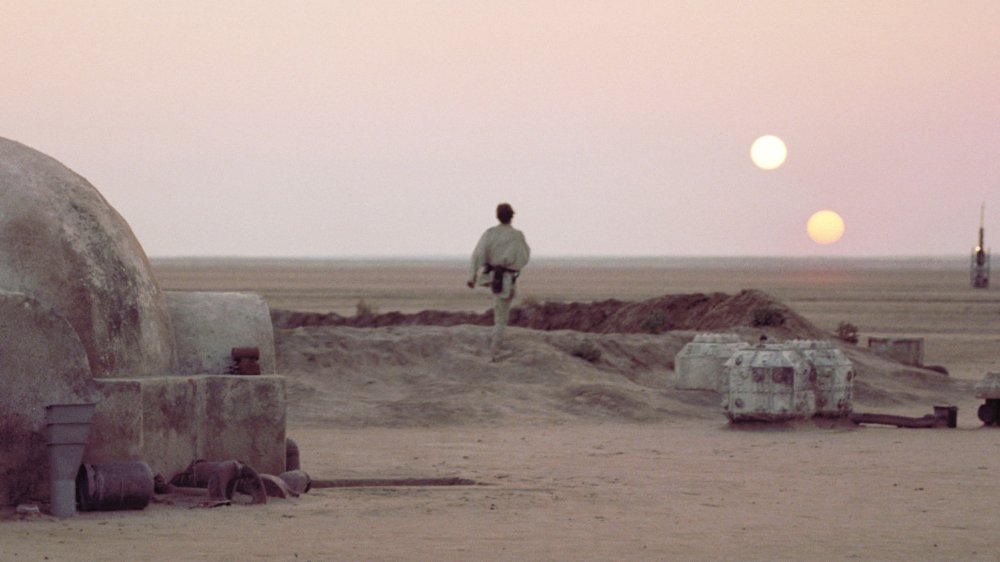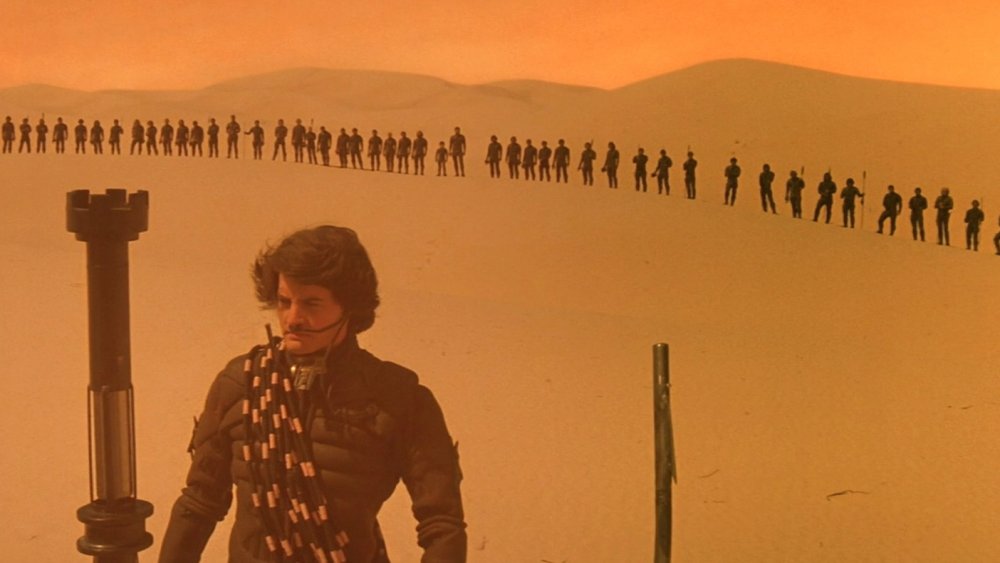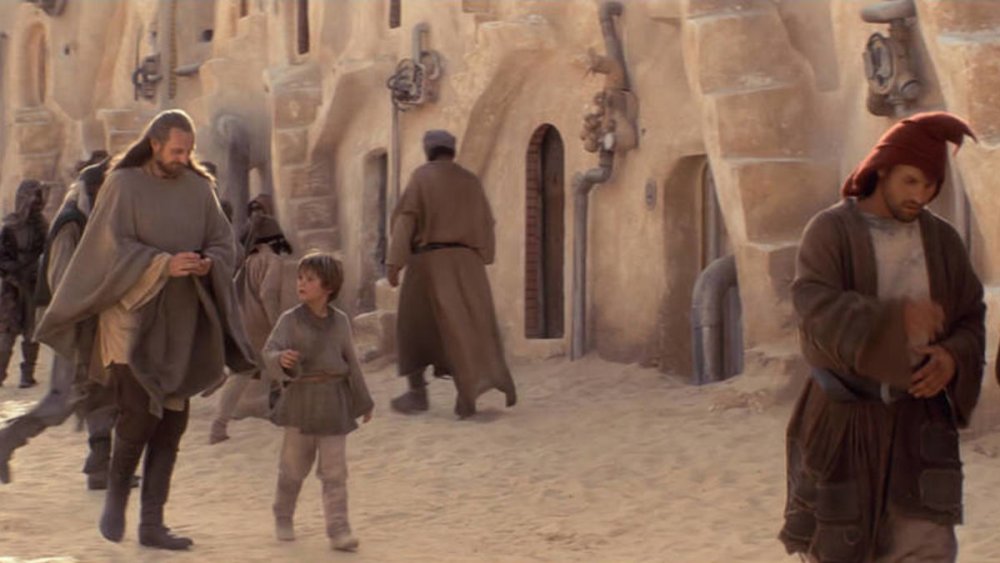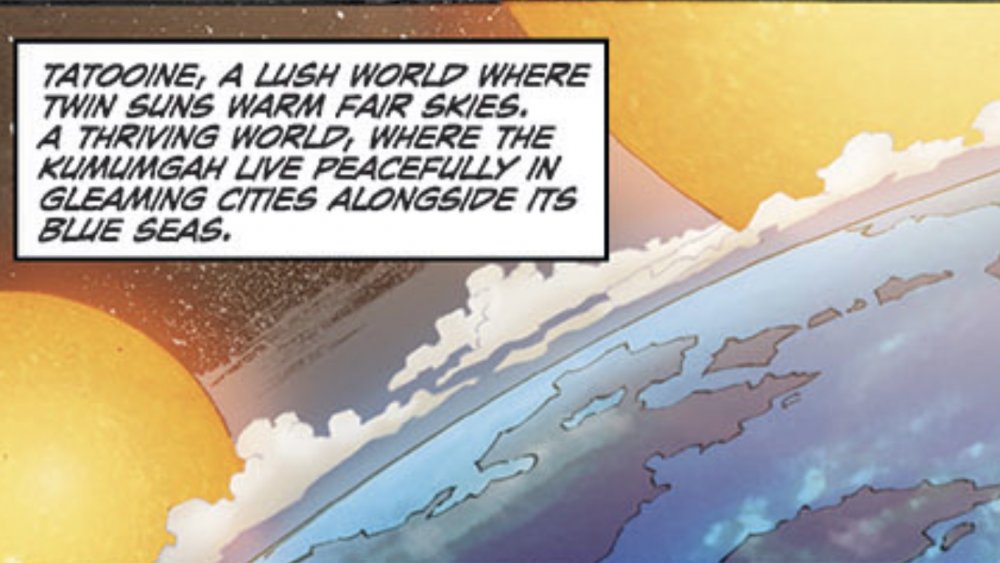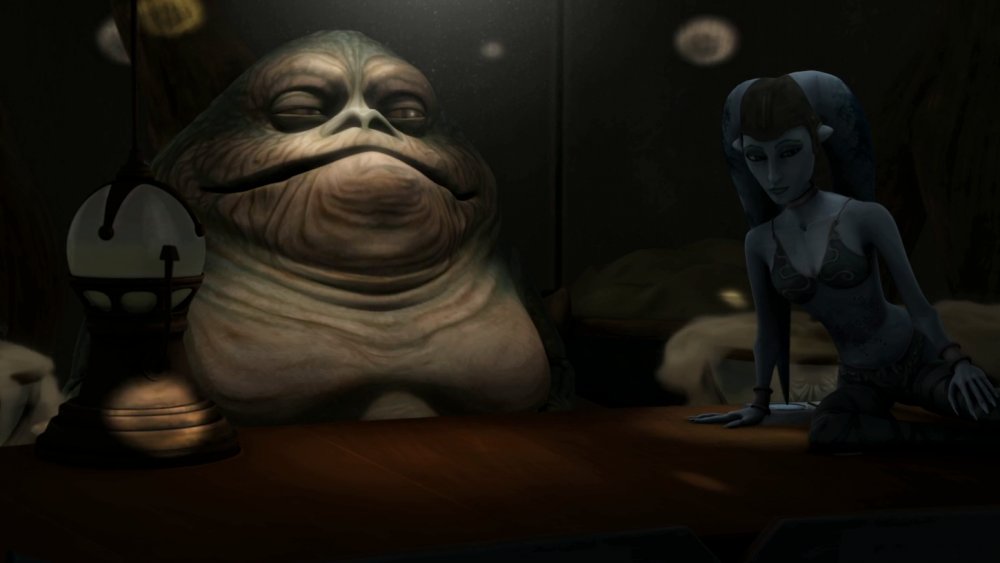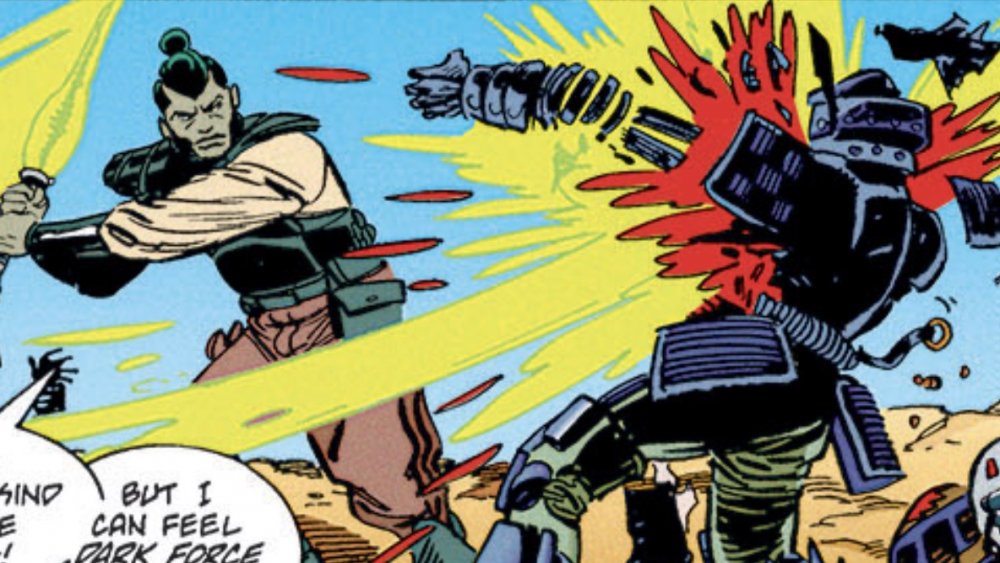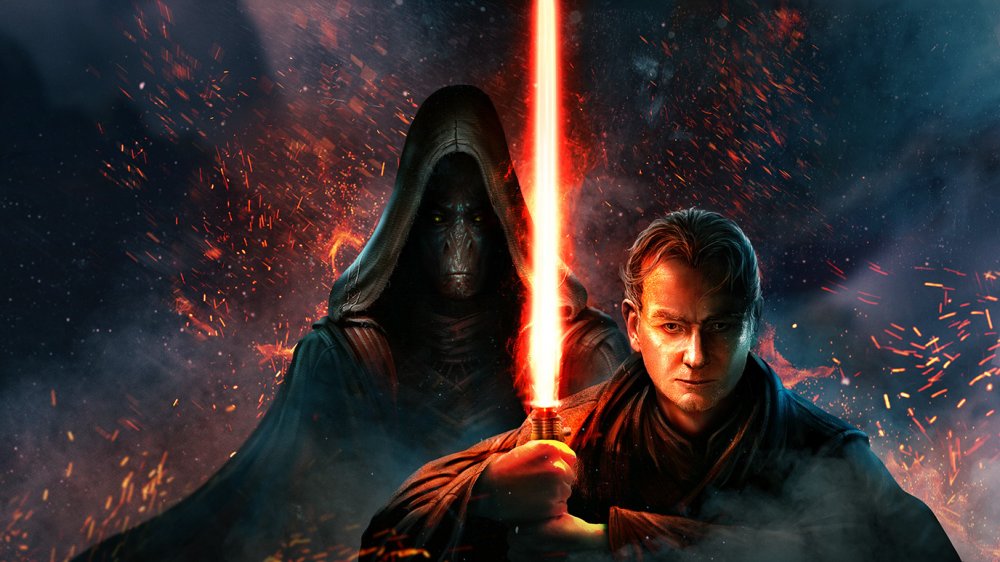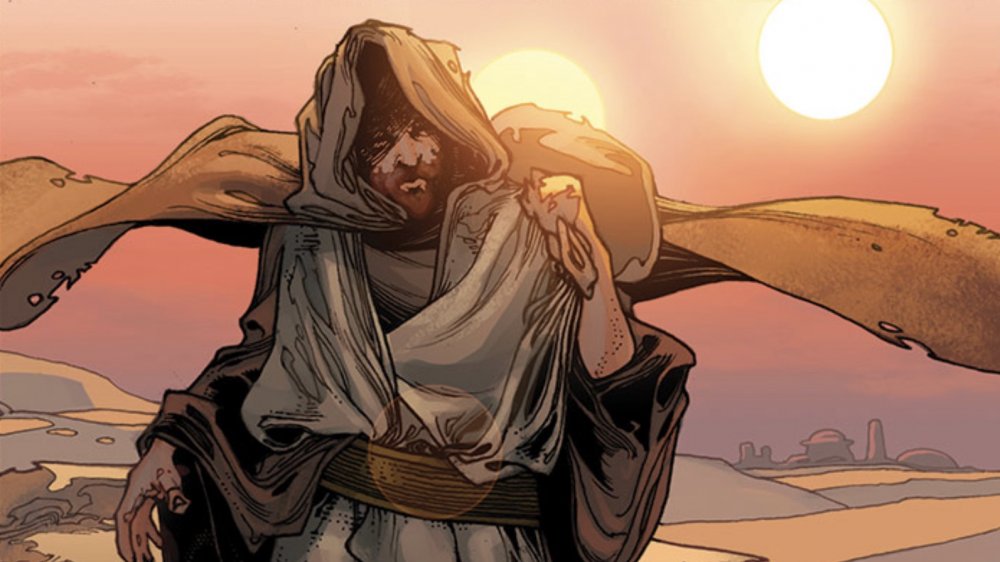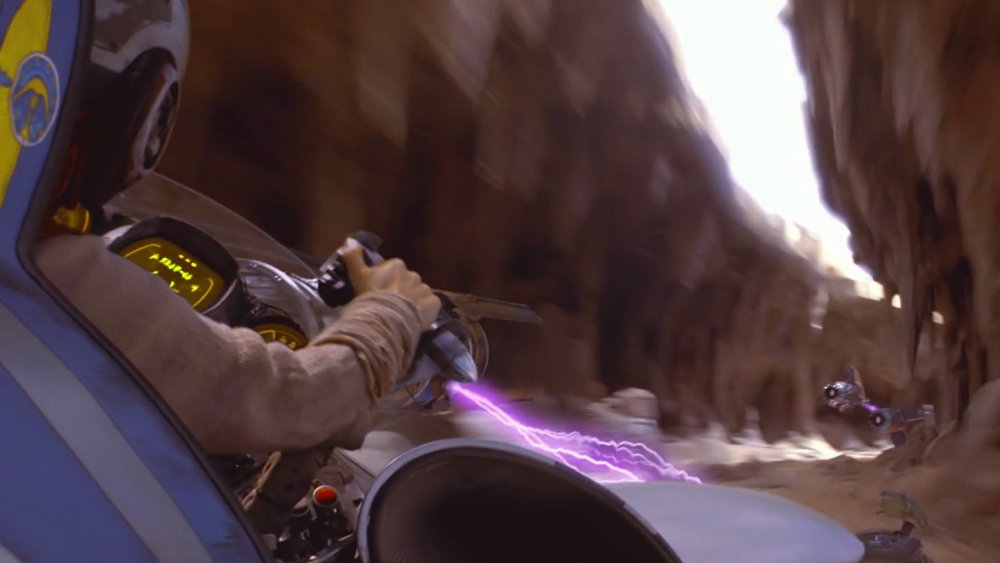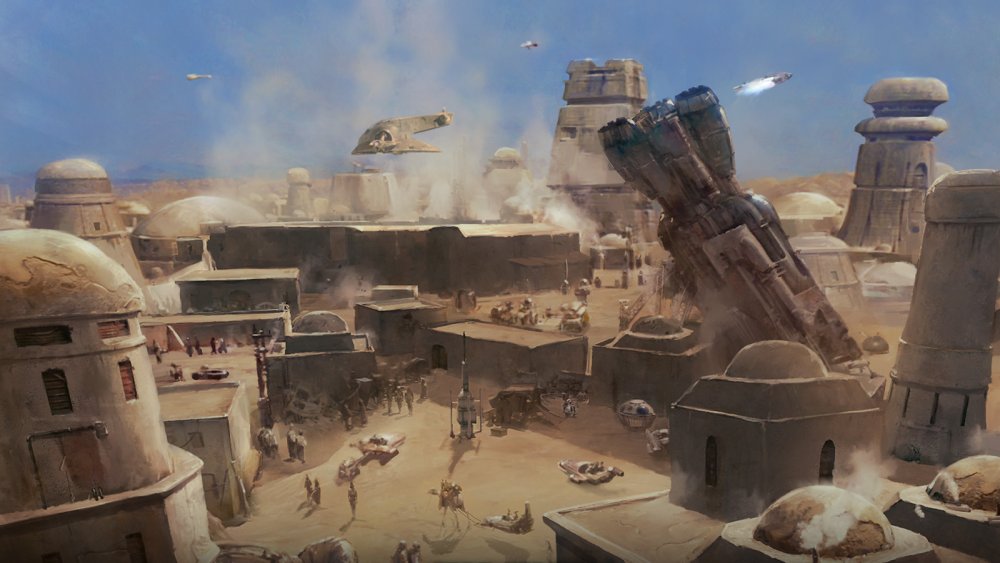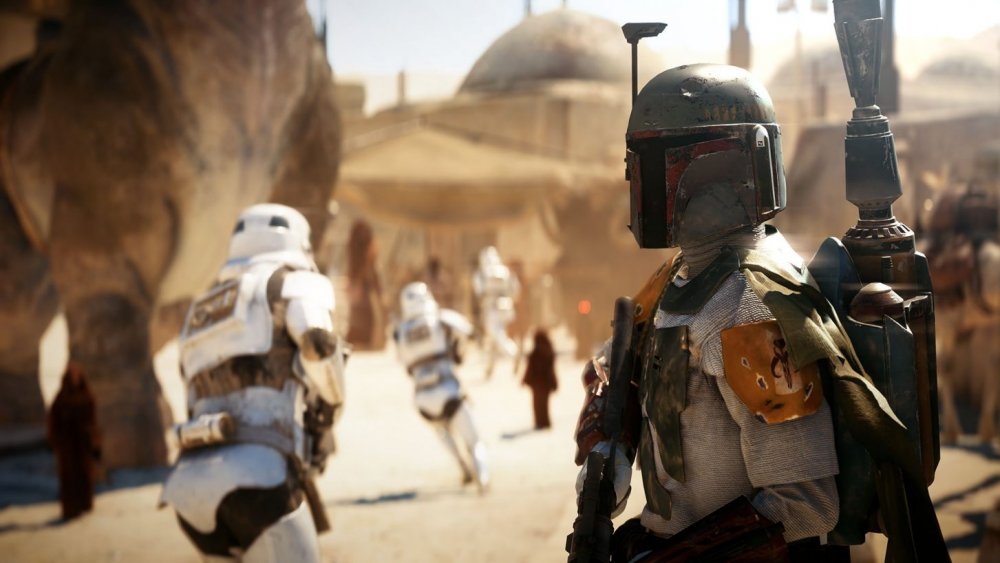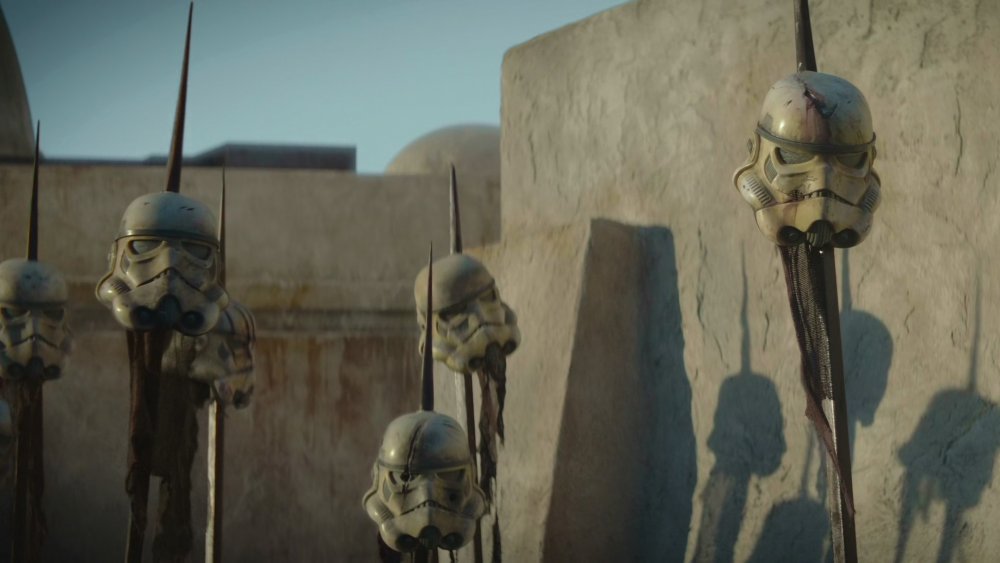The History Of Tatooine Fully Explained
"If there's a bright center to the universe, you're on the planet that it's farthest from."
This is how Luke Skywalker describes his homeworld of Tatooine in Star Wars: Episode IV — A New Hope. In the fictional galaxy where Star Wars is set, Tatooine is indeed a backwater planet, set in the Outer Rim Territories far from the wealthy and powerful core worlds. But while it's superficially just a dusty planet of gangsters and moisture farmers, there's no place more central to the mythology of Star Wars than Tatooine. It's been visited in five of the nine films in the Skywalker Saga, multiple television shows, and countless novels, comics, and video games.
The history of Tatooine is divided into three distinct but overlapping universes. There's the current Star Wars canon, which includes all of the films, the recent animated series, and any books or games created after Disney purchased Lucasfilm in 2012. There's Star Wars Legends, the expanded universe that grew out from the films between 1977 and 2012, some of which still counts, but most of which doesn't. And, of course, there are Tatooine's origins here in our own world, where our story begins in the early 20th century...
Tatooine's deep sci-fi roots
They say there's nothing new under the sun — in the case of Tatooine, make that "suns." Star Wars, like any work of fiction, wasn't created in a vacuum, it was inspired by a variety of existing works that sparked something in filmmaker George Lucas. Star Wars is a mashup of Akira Kurasawa's The Hidden Fortress, John Ford westerns, and pulp science fiction, particularly 1930s Flash Gordon serials and Edgar Rice Burroughs' John Carter of Mars, which dates all the way back to 1912.
Tatooine bears a resemblance to Burroughs' fictional version of Mars, but its most direct ancestor seems to be the planet Arrakis from Frank Herbert's 1965 novel Dune. Arrakis is a barren desert world where residents must harvest and recycle moisture to live (much like the Skywalker/Lars family business) and where carnivorous beasts lurk under the sand (like Return of the Jedi's Sarlacc). Star Wars hasn't shied away from an occasional deliberate nod to Dune, either, such as C-3PO's offhand reference to the "Spice mines of Kessel." Dune and Star Wars share a lot of influences, such as the aforementioned Burroughs, but the two epics have so much in common that it's not much of a stretch to call Tatooine a direct descendent of Arrakis.
Tatooine is a place on Earth (sort of)
Called Utapau in earlier drafts of the screenplay (a name that would later be reused in Revenge of the Sith), Tatooine takes its name from Tataouine, a city in Tunisia not far from where the desert portions of A New Hope were originally filmed. Much of the iconic imagery associated with Tatooine is based upon existing Tunisian structures, both historical and contemporary. Some of the sets created for A New Hope, The Phantom Menace, and Attack of the Clones, as well as some real local buildings that were featured in the film, are still standing and have become tourist attractions.
Tatooine's arid deserts have also been portrayed by American deserts Yuma, Arizona and Death Valley National Park in California, where the exterior Tatooine scenes in Return of the Jedi were shot. Our real-life history of Tatooine ends in Jordan, where the final scene of The Rise of Skywalker was filmed. While it's been reported that some exterior shooting for The Mandalorian was performed in Death Valley, the series' locations are mostly brought to life in-studio using Lucasfilm's new "Stagecraft" technology, which makes it unlikely that any more pieces of Tatooine will be built here on Earth.
So to continue the history of Tatooine, we'll have to go back to a long, long, time ago in that galaxy far, far away...
Green Tatooine and the Kumumgah
We know Tatooine as an inhospitable desert world, but that has not always been the case. The canon reference book Ultimate Star Wars confirms that Tatooine once had forests and oceans, but that some unknown event permanently changed the climate of the planet. In the current, Disney-maintained history of the Star Wars universe, there's no official explanation of how Tatooine became the dry rock we know today, which means this piece of part of the story is still the stuff of Legends.
As revealed in the codex of the video game Knights of the Old Republic and the comics series Dawn of the Jedi: Force Storm (both of which are now apocryphal), an ancient race called the Kumumgah lived on the lush and vibrant Tatooine 25 millennia before the rise of the Galactic Empire. The Kumumgah developed interstellar travel and started colonizing nearby space, which attracted the attention of the massive, advanced Infinite Empire. When the Kumumgah resisted being colonized and enslaved by the Infinite Empire, the Empire made an example of them by bombarding Tatooine until it turned to glass, which broke into sand over centuries. In the ensuing age between the siege of Tatooine and the time of The Phantom Menace, the Kumumgah are believed to have adapted to their new desert environment by evolving into two different species — the Jawas and the Tusken Raiders.
Good for nothing but doing bad
Most of the written history of Tatooine before The Phantom Menace is now consigned to Legends canon, but before the timeline was reset, a number of stories set in the distant past of Star Wars centered around efforts to make something of the desiccated planet. After the tragedy of the Kumumgah, the Wizards of the Coast RPG sourcebook Secrets of Tatooine places the next attempted settlement of the planet by non-Tatooinians at about 4200 BBY (before the Battle of Yavin in A New Hope), but the colony struggles and eventually fails. According to the Knights of the Old Republic codecs, Tatooine alternates between being an independent world and a Senate protectorate for centuries. The Republic would move in and give up on Tatooine at least four times. Big industries like mining and weapons testing try to set up shop on Tatooine, but these operations are always short-lived.
Only one business ever seems to have thrived on Tatooine: crime. By 3641 BBY (the setting of the MMORPG The Old Republic), the backwater planet becomes a base of operations for the criminal organization known as the Hutt Cartel. For them, Tatooine being a remote, inhospitable world that has little to offer the Republic or legitimate business is a plus. The Hutts use Tatooine as a base for smuggling, gambling, and sentient trafficking for millennia. Once it became a hub for the black market, Tatooine finally found its destiny as a seedy trading port.
Tatooine's first Jedi, Dace Diath
Tatooine is most famous as the homeworld of Anakin Skywalker and his son Luke, who would each become Jedi Knights and shape the history of the galaxy in different ways. But while they are the planet's most famous practitioners of the Force, according to Legends canon, they are not the first. They are preceded by another father and son, who train together in the Jundland Wastes not far from what would become known as Lars Homestead, where Luke later grows up.
About 4000 years before Anakin's birth, Jedi Master Sidrona Diath brings his son, Dace Diath, to the isolation of Tatooine's desert to teach him in the ways of the Force. Dace struggles to match his father's skills, but Sidrona is a patient teacher who believes that Dace's longer journey toward the Force will ultimately make him a better teacher than himself. During a difficult trial described in the 1996 Tales of the Jedi Companion RPG source book (based upon the Dark Horse comics line), Dace becomes lost in Tatooine's Dune Sea and discovers that his frustration is his only enemy, and that self-belief is his greatest ally. Dace becomes the first Jedi to be forged in the heat of Tatooine.
In the Tales of the Jedi comics cycle, Dace Diath fights valiantly in the Great Sith War, but is killed in one of the war's most terrible massacres, his ship destroyed by a supernova deliberately induced by Sith sorceress Aleema Keto.
Tatooine, center of circumstance
In 42 BBY, a slave on Tatooine named Shmi Skywalker gives birth to a son, Anakin, whose conception is a total mystery to her. According to the Legends novel Darth Plagueis by James Luceno (and heavily implied in the canon film Revenge of the Sith), Anakin is the result of an experiments performed by Sith Lord Darth Plagueis and his apprentice, Darth Sidious. Plagueis and Sidious' combined efforts shift the Force to favor the Dark Side, granting Plagueis superior influence over life and death, but the Force reacts against them, resulting in the immaculate conception of Anakin Skywalker on far-off Tatooine without Plagueis' knowledge.
Ten years later, a total coincidence (or, if you prefer, the will of the Force) brings Anakin to the attention of the Jedi and the Sith in The Phantom Menace. A spacecraft carrying two Jedi and Queen Amidala of Naboo is forced to stop for repairs on Tatooine, near the city of Mos Espa, where they find Shmi and Anakin Skywalker. Shmi informs Jedi Master Qui-Gon Jinn of Anakin's mysterious birth, and Jinn takes Anakin back to Coruscant to train in the Jedi arts. After Anakin is turned to the Dark Side by Sidious, Jedi Master Obi-Wan Kenobi brings Anakin's infant son back to Tatooine to be raised by Shmi's stepson Owen Lars and his wife Beru. 19 years after that, another random happenstance brings his twin sister Leia's starship past Tatooine, setting the events of the Original Trilogy into motion.
Old Ben Kenobi and the Great Drought
For the 19 years after the fall of the Jedi Order, Jedi Knight Obi-Wan Kenobi hides away in Tatooine's Dune Sea. While his comrades-in-arms are being systematically hunted across the galaxy by Darth Vader and his Inquisitors, Kenobi keeps his identity a secret, going by the pseudonym "Ben" in order to abide by his oath to protect the young Luke Skywalker from harm. It is Kenobi's intention to train Luke as a Jedi, but Luke's guardian and uncle Owen Lars demands that Kenobi stay out of Luke's life, for fear that he may meet a fate as grisly as Anakin's.
While he is barred from training the boy, this doesn't keep Kenobi from looking after him from a distance, offering what turns out to be much-needed protection. In 11 BBY, Tatooine is struck with a drought that makes water an even more precious commodity than usual. The Lars family, being moisture farmers, become the target of a "tax" by Jabba the Hutt's organization, and Kenobi is forced to intervene to keep them and their farm safe. This nearly blows Kenobi's cover when Jabba hires a bounty hunter to kill whoever's been repelling his goons, but once the drought ends and the raids cease, things quiet down once again and Kenobi returns to his life as Luke's silent guardian.
These events are depicted in issues #7, #15, and #20 of the canon Star Wars comics title that ran from 2015 to 2019.
Tatooine's long gearhead tradition
While not a major center of speeder and ship manufacturing like Corellia, Tatooine has a decades-old hot rodding tradition. Like in a lot of other boring places to grow up, a common pastime among the youth of Tatooine is finding out how fast you can get your machine to go, and betting your life on your skills as a driver or pilot. The Boonta Eve Classic, which takes place in Beggar's Canyon, is the Star Wars galaxy's equivalent of the Indy 500, drawing racers and fans to the planet annually and sparking dreams of glory in plenty of residents, including Anakin Skywalker, the first human to successfully complete a regulation podrace (and at just nine years old).
While there are no references to podracing in A New Hope, Anakin's teenage son Luke is part of a crew of hot-rodders in nearby Anchorhead about 35 years later. Along with other local pilots like Biggs Darklighter, Luke also races through Beggar's Canyon, but in an airborne T-16 Skyhopper, where he learns the skills that eventually allow him to navigate the trench of the first Death Star and become a hero of the Rebel Alliance.
Luke's American Graffiti-style gearhead crew was cut out of A New Hope, but lives on in the film's novelization, audio drama adaptation, and in other expanded universe works. The Beggar's Canyon run itself has been immortalized in video games such as Rebel Assault and the Rogue Squadron trilogy.
Mos Eisley and the Dowager Queen
About a century before the Battle of Yavin, a colony ship called Dowager Queen crash lands on Tatooine during a sandstorm. The survivors build a town which they call Eisley, later renamed Mos Eisley in deference to the conventions of preexisting Tatooine cities such as Mos Espa. The Dowager Queen remains lodged at an angle in the sand, where it is converted into a hotel and becomes one of the city's most recognizable landmarks. (Dowager Queen is visible in every cut of A New Hope, but its backstory is fleshed out in the Legends video game Star Wars Galaxies.)
Mos Eisley grows into a shady spaceport town that earns a reputation as a "wretched hive of scum and villainy." While the Galactic Empire technically rules over all of Tatooine after the fall of the Republic, Mos Eisley is in fact controlled by crime lord Jabba Desilijic Tiure, a.k.a. Jabba the Hutt, to whom even Darth Vader has to pay a degree of deference, until Jabba's death in the year 4 ABY. The citizens of Mos Eisley don't seem too broken up over the loss of their de facto mayor — a short time later, the Empire suffers a crushing defeat at the Battle of Endor, and the people of Mos Eisley take to the streets to celebrate their newfound freedom.
This planet's not worth dying over
Tatooine is one of, if not the most iconic planet in Star Wars, but when you think back upon the films and cartoons, you might be surprised to realize that the actual "Star Wars" themselves barely touch the planet at all. Tatooine is remote, sparsely populated, and resource-poor — in short, it's strategically worthless. It's a setting for smaller, lower-stakes action and character stories, like podraces, the battle on Jabba's sail barge, and the shortest, most satisfying lightsaber duel in the franchise, not for huge military clashes.
That's not to say that the Clone Wars, Galactic Civil War, and the First Order-Resistance War left the system totally alone. Since video games in the Star Wars franchise are considered canonical, any time a stage in a shooter, strategy game, or flight simulator is set on or around Tatooine, this is considered to represent some real battle in the chronology of Star Wars, either in Legends or Disney canon. This had led to a number of small, insignificant skirmishes being scattered throughout the history of Star Wars, justified by the desire to allow fans to run around Mos Eisley spaceport playing Capture the Flag or survival missions. (A noble enough goal, in our opinion.)
Tatooine after the war
Life on Tatooine doesn't seem to change much after the defeat of the Empire, though there have been relatively few stories set there after the Galactic Civil Ear in the new canon. The Aftermath trilogy of novels, set just after Return of the Jedi, confirm that the death of Jabba the Hutt leaves a power vacuum in the criminal underworld of the Outer Rim. An upstart organization called the Red Key Raiders uses the pretense of a legitimate mining operation to attempt to gain a foothold before the New Republic can get organized and chase them out, but their plans are foiled, at least in the short term.
The Mandalorian episode "Chapter 5 – The Gunslinger" is set the following year, and sees the titular hero visit Mos Eisley, where one street is lined with Stormtrooper helmets skewered on pikes, indicating a bloody victory over the remaining occupying Imperials. But apart from the new decor, it's business as usual for the old wretched hive, with smugglers and bounty hunters aplenty trying to eke out a marginally honest living on the outskirts of the galaxy.
Tatooine is only visited at the very end of the Sequel Trilogy, when Rey takes a pilgrimage to Lars Homestead to bury the Skywalker family lightsabers. Given that the Skywalker Saga has ended and Tatooine is so closely tied to the Skywalker legacy, whether or not we see any subsequent adventures set on the desert planet is anyone's guess.
